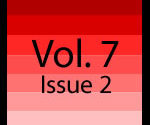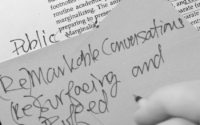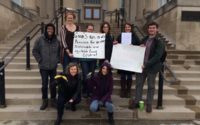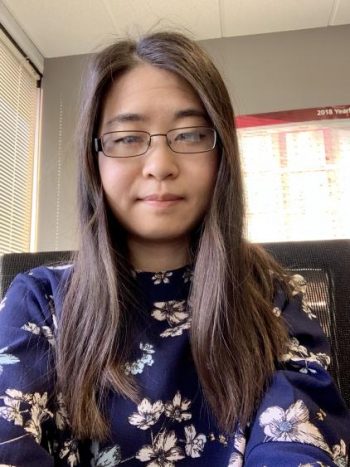Bounding Postpartum Care: Reviewing the Role of the Yuesao in Urban China
In Bounding Biomedicine, Colleen Derkatch investigates the boundaries drawn between biomedicine and CAM (Complementary and Alternative Medicine) by European and North American healthcare professionals and commentators, noting that many supposedly “multidimensional models of science” produced in the West continue to bolster biomedicine’s authority in the public realm (168). In this article, I use Derkatch’s conceptualizations of boundaries of care and boundaries between conceptual care frameworks1 to evaluate the figure of the yuesao, a Chinese postpartum care provider. To explore these boundaries, I utilize yuesao testimonials and profiles from 58 Home, a popular Chinese yuesao platform and crowd-sourced review site. I argue that the yuesao’s postpartum care, unlike the care practices Derkatch examines in Newsweek reports, and JAMA and Archives theme issues, employs a true integrative approach that affirms the practices and underlying theories of multiple conceptual frameworks. In addition, I describe the yuesaos’ work in promoting the psychological well-being and family harmony of Chinese postpartum women, suggesting that yuesaos are extending the boundaries of postpartum care to fulfill needs created by prevailing Chinese cultural and political conditions. Ultimately, this article aims to provide additional perspectives on postpartum health and medical communication in the Chinese context.
The Context Affecting Communication
In 2014, the World Health Organization described the postpartum period as a critical yet heavily neglected period for mothers and infants (“WHO Recommendations”). In the West, postpartum women are often simply given basic recommendations after childbirth, with warnings to visit their doctors if complications arise. In China, however, millions continue to practice “sitting the month,” otherwise known as postpartum confinement (PC): staying indoors, consuming specialized diets, and avoiding cold elements during the month immediately following childbirth (“A Tradition for New Mothers in China”). Supporters of PC attribute the beginning of the practice to the Confucian Book of Rites (see Chai), claiming that PC derives its legitimacy from centuries of practice as well as various principles of traditional Chinese philosophy and medicine. Individual women practicing PC are permitted to customize their PC regimens according to their own needs and their families’ desires, with some only consuming the specialized diets and others following all traditional practices while also avoiding modern electronic devices and enjoying other relaxing activities such as yoga and spa baths (“Forum Topic”). PC supporters believe that, after practicing PC successfully for a month, instead of feeling drained by childbirth and suffering from postpartum complications, a postpartum woman will emerge healthy, refreshed, and ready to embrace, and excel at, her new responsibilities.
In affluent, urban areas, Chinese women are increasingly hiring yuesaos (月嫂), live-in specialized doulas, to assist them during the postpartum period.2 The postpartum woman is given a period to rest as the yuesao manages the client’s household and well-being. The yuesao is expected to monitor the health of the client and infant, provide the client with vitality-restoring meals, instruct and counsel the client regarding recovery and breastfeeding, and mediate household and health-related division of labor within the household (see, for example, “Yuesao Profile: Ms. Xu.”). Yuesaos are considered by their clients to be among the most authoritative postpartum care providers in China, commanding similar levels of trust and respect during the postpartum to OB/GYNs during the periods before and during childbirth.
Yuesaos, unlike Chinese physicians, do not operate through clinics and hospitals. They often work through yuesao platforms, reaching clients through online advertisements, agency websites, and positive word of mouth on Wechat, China’s “super” social media app. The heavily censored nature of the Chinese Internet,3 as well as stringent regulations on the yuesao industry, mean that all circulating yuesao images, practices, and rhetoric, whether they be self-curated or involuntarily government-curated, must conform to current cultural and political expectations for Chinese healthcare providers and communicators. Specifically, the yuesaos’ practices can be anticipated to stay broadly in line with, and likely affirm and reinforce, Confucian cultural values as well as the healthcare conceptual frameworks endorsed by the Chinese state. A study of yuesaos’ online presence reveals both the features of a healthcare framework that complies with the leading ideologies of the Chinese government (integration between TCM and biomedicine) and a new frontier of care growing out of Chinese social and cultural conditions (a holistic care model that incorporates emotional and socio-cultural support).
Integrating TCM and Biomedicine
Many of the yuesaos’ signature practices, such as qi-restoring food/herbal therapy, have been generally categorized as CAM practices in Western literature (Fugh-Berman 137). Within China, however, yuesaos are well-known to traverse between CAM and biomedical frameworks and combine the two into one singular practice.The yuesao exhibits fluency in the terminologies, theories, and practices of both frameworks, establishing herself as a healthcare provider willing to support the client using her knowledge and expertise in either (or both) frameworks and accepting that situations may potentially arise from the entanglements between the frameworks. The postpartum foods prepared by the yuesao for her client, for example, are typically justified as beneficial by both biomedical practitioners and TCM practitioners. The brown sugar water and mild soups recommended for the first two weeks of the postpartum are said to both hydrate the yuesao’s client, reducing her chances of developing hemorrhoids, and return her body to an equilibrium state, making her more receptive to the vitality-restoring ingredients she will later consume. When a postpartum woman failed to breastfeed, the yuesao not only examined her for signs of breast duct obstruction, infection, and inflammation but also included more breastmilk-boosting and anti-stagnation TCM food ingredients in her diet (“Yuesao Profile: Ms. He”), thus addressing several possible causes of the problem at once and eliminating the possibility that her internal fluid stagnation has exacerbated a likely case of mastitis.
Unlike the Newsweek special report Derkatch investigates, Chinese yuesao accounts do not produce an “imperial” kind of framework. That is, they do not, as Derkatch’s explains, position one framework as the final arbiter of whether practices from another framework are deemed safe and effective (164). Yuesao testimonials and profiles show that the yuesao prioritizes the client’s reported experience and response to care over the theoretical foundations and validity of the care practices the yuesao has employed. The yuesao remains untroubled by the facts that treatment regimens often cannot be universalized (meaning they cannot be verified under the biomedical framework) and external environmental factors often turn out to have had negligible effects on a client’s health (meaning a central tenet of TCM has been breached). To the yuesao, biomedical and CAM practices are tools of equal standing, both supplying potential instruments that the yuesao can use in a bricolage-resembling process to achieve the goal of improved health for her client.
The yuesao’s view of biomedical and CAM practices as interchangeable building blocks for an assembled, individualized care regimen is also reflected in the visual layout of the 58.com yuesao profiles. Each yuesao’s list of skills and practices are divided into four sections; although each section features practices from both frameworks, the practices’ frameworks of origin are not listed, and practices such as traditional Chinese foot baths are listed right above biomedical practices focusing on uterine and ovarian maintenance and recovery (see, for example, Ms. Xu’s profile). Like the CAM-oriented chiropractors described by Derkatch, yuesaosoften provide their clients with an “orientation” at the start of the care program, assessing the client and aligning the client’s explanatory model with their own (120). However, unlike the chiropractor who strives to align the client’s model with the chiropractic one, the yuesao strives to make the client open to all practices from the two frameworks—the goal, the yuesao stresses, is the client’s own optimum state of health and the composition of the care regimen may change at any moment, depending on the client’s experiences and desires.
The unique healthcare framework of Chinese yuesaos may trace its roots to Deng Xiaoping’s pragmatist philosophy of governance4 and China’s current unique state ideologies. China has become famous for pursuing policies “with Chinese characteristics,” eschewing numerous established theories and systems, such as the free market economy for new experiments including what has been termed “the socialist market economy” (Sigley 488). For both the Chinese government and Chinese yuesao, the exact composition of practices that make up a final policy or healthcare regimen has become less relevant than the overall appropriateness and effectiveness of the final assemblage. Currently, both the scientific biomedical framework and the “Chinese” TCM framework are esteemed, due to the government’s desire to pursue a “scientific outlook on development” while encouraging “cultural self-confidence.” An integrative framework fulfills these ideological goals well by blurring the boundary between the two frameworks, while carefully balancing their influence.
Extending the Boundaries of Care
In TCM theory, having just given birth, the postpartum body is “hollow” (虚) and “stagnated” (滞), as well as susceptible to “postpartum diseases” (月子病), chronic, debilitating condition(s) that leave women discomforted for the rest of their lives (Chinese Family News). Yuesaos, laboring to prevent the onset of postpartum diseases, appear to fit comfortably into Western biomedical practitioners’ narratives of healthcare practitioners working to prevent or treat illness. However, many postpartum women forgo describing their yuesaos’ work on improving their physical health in favor of praising their yuesaos’ emotional support:
She is outgoing and optimistic but not garrulous, really enlivened the whole house… had a cordial relationship with my family members and negotiated well with everyone… She always counseled me and compassionately listened to my confessions… Meeting her was [like meeting] a ray of sunshine in the winter. (“Yuesao Profile: Ms. Fu.”)
Regardless of framework, empathy and compassion are highly valued traits in healthcare providers and communicators, yet the high frequency with which yuesaos post such heartwarming reviews and promise their clients joyful postpartum experiences speak to a unique niche filled by the yuesao. The yuesao is now serving as a guardian of the client’s emotional as well as physical health, relieving interfamily tensions, serving as a confidante, and shouldering the client’s duty to maintain the health of both herself and her infant.
Both biomedical and TCM frameworks aim to improve physical health and protect postpartum women from postpartum disease. However, the combined requirements of postpartum confinement and social pressures of performing as filial Confucian family women are great. As a result, Chinese postpartum women often become isolated and stressed during the postpartum month. Barred from physical visitors, often barred from social media, and frequently called upon to host visiting extended family members, many postpartum women experience boredom, frustration, and depression. In more Confucian families, conflict often arises when postpartum women with newborn daughters are pressured to recover quickly so they can immediately try again to conceive a son and extend the family bloodline (“Forum Topic”).
Noting a present deficiency in support services available to postpartum women, many yuesaos have extended their spheres of responsibility and care as healthcare providers. For yuesaos, doing so not only offers them the chance to advertise themselves to the public as holistic healthcare providers with an extended definition of care but also enables them to exploit the “harmonious family and society” Confucian ethos and frame their care as a social good. If Chinese postpartum women are said to eventually become “mothers of the nation”—a view that was popularized at the beginning of the twentieth century (Judge 111) and has since been influential in the public consciousness—yuesaos can become “aunts” or “grandmothers” of the nation by serving their clients in an emotionally intimate role.
Within the extended sphere of care, the yuesao cares for the client by becoming and serving as an exclusive ally for the client. The yuesao signs her contract only with her client, guaranteeing her loyalty to the client within the client’s chaotic family environment. Moreover, since yuesaos are certified by the Chinese government, a yuesao can command respect from the in-laws and advocate for the client as well as the client’s agency in creating her postpartum regimen without placing the client in an unfilially confrontational position. The yuesao, as a fellow woman and the client’s health navigator, also serves as the client’s rhetorical proxy. The client presents and claims the yuesao’s health knowledge and daily work as her own through emphasizing the client’s employment of the yuesao, and the client can also extract herself from any responsibility and blame for any potential harm to her health as well as that of her infant by utilizing the yuesao as a scapegoat. The most highly rated yuesaos are simultaneously everywhere and nowhere: They cover the most ground in making the postpartum experience as smooth as possible for the clients while allowing the clients to shine as the stars of the performance. Through the postpartum, they remain always at their clients’ sides, ready to support their clients through any challenges to their health and happiness, and ready to further expand boundaries of care.
Conclusion
Chinese yuesaos are a unique group of healthcare providers who liberally assemble practices and ideas from biomedical and TCM health frameworks to care for Chinese postpartum women. Yuesaos’ practices and framework are heavily influenced by both prevailing Confucian cultural values and the political ideologies of the ruling Chinese regime, and may transform with any future shifts in those macro factors to continue conforming to the status quo. A current focus on the emotional as well as physical well-being of postpartum women has arisen and been incorporated into yuesao practice due to an otherwise unmet need for support in postpartum Chinese women. Due to China’s large population size and significant cultural influence, Chinese practices and frameworks are vital for an informed global picture of women’s reproductive health discourses. A comparative study of the yuesaos’ framework and practice in China and biomedical practitioners’ framework and practice in the West may provide additional insight on improving postpartum women’s health outcomes, willingness to seek care, and preferred communication models.
Notes
- I use “conceptual frameworks” in this article to refer to what may otherwise be called “paradigms” or “cosmologies”—David Greaves noted that Kuhn had limited the term “paradigm” to scientific ideas in Kuhn’s paradigm theory (82), and the scope of this article is too narrow to justify using “cosmology.” return
- The first character of yuesao, yue (月), refers to the moon, and, over time, acquired the meanings of “month” and “the menses,” in addition to becoming associated with the concepts of yinand the feminine. The second character, sao (嫂), refers to an older married woman. return
- Chinese censors have been known to curate circulating media content through erasure, selective filtering, and algorithm manipulation, allowing Internet users to only access state-endorsed ideologies and industry workers (in this case healthcare frameworks and providers). Health and wellness practices like qigong that incorporate TCM elements yet remain outside of the scope of the state-endorsed framework are often suppressed. return
- Deng, the paramount leader of China from 1978 to 1989, once commented that “it doesn’t matter if a cat is black or white, so long as it catches mice.” return
Works Cited
- Chai, Chʻu, and Winberg Chai, editors. Li Chi: Book of Rites: An Encyclopedia of ancient ceremonial usages, religious creeds, and social institutions. Vol. 2, University Books, 1967.
- Chen, Jie. “Xi: Build China’s Cultural Confidence.” China Daily. Publicity Department of the Central Committee of the Communist Party of China, 1 Dec. 2016, www.chinadaily.com.cn/china/2016-12/01/content_27532284.htm. Accessed 1 Jan. 2019.
- Chinese Family News. “Telling You Why Chinese ‘Sit the Month’ from a Traditional Chinese Medicine Perspective.” Sohu Health, Sohu Inc., 8 May 2017, www.sohu.com/a/139003750_473555. Accessed 20 Aug. 2018.
- Deng, Iris, and Celia Chen. “How WeChat Became China’s Everyday Mobile App.” South China Morning Post. Alibaba Group, 16 Aug. 2018, www.scmp.com/tech/article/2159831/how-wechat-became-chinas-everyday-mobile-app. Accessed 1 Jan. 2019.
- Derkatch, Colleen. Bounding Biomedicine: Evidence and Rhetoric in the New Science of Alternative Medicine. University of Chicago Press, 2016.
- “Forum Topic: The Delivery and Post-Delivery Periods.” Sina Childcare, Sina Corp, 20 July 2017, baby.sina.com.cn/fenmian/. Accessed 20 Aug. 2018.
- Fugh-Berman, Adriane, and Fredi Kronenberg. “Complementary and Alternative Medicine (CAM) in Reproductive-Age Women: A Review of Randomized Controlled Trials.” Reproductive Toxicology, vol. 17, no. 2, 2003, pp. 137–52.
- “Introduction to the Scientific Outlook on Development (compiled and translated by the Central Compilation and Translation Bureau (CCTB) of China).” Fondation Gabriel Péri, www.gabrielperi.fr/1380.html. Accessed 1 Jan. 2019.
- Judge, Joan. “Blended Wish Images: Chinese and Western Exemplary Women at the Turn of the Twentieth Century.” Nan nü, vol. 6, no.1, 2004, pp. 102–135.
- Levin, Dan. “A Tradition for New Mothers in China, Now $27,000 a Month.” New York Times. A.G. Sulzberger, 1 Oct. 2015, www.nytimes.com/2015/10/02/business/international/china-confinement-care-for-new-mothers-now-27000-a-month.html. Accessed 1 Jan. 2019.
- Sigley, Gary. “Chinese Governmentalities: Government, Governance and the Socialist Market Economy.” Economy and Society, vol. 35, no. 4, 2006, pp. 487–508.
- “WHO Recommendations on Postnatal Care of the Mother and Newborn: 2013.” Geneva: The World Health Organization, 2014, Accessed 1 Jan. 2019.
- “Yuesao Profile: Ms. Fu.” 58 Home, 58.com, 20 August 2018, tj.daojia.com/yuesao/40000000277450/. Accessed 20 August 2018.
- “Yuesao Profile: Ms. He.” 58 Home,58.com, 20 August 2018, wh.daojia.com/yuesao/40000000229967/. Accessed 20 August 2018.
- “Yuesao Profile: Ms. Xu.” 58 Home, 58.com, 20 August 2018, wh.daojia.com/yuesao/40000000235315/. Accessed 20 August 2018.
Keywords: postpartum confinement, boundaries of care, CAM (contemporary and alternative medicine), China, TCM (traditional Chinese medicine)
Cover Image Credit:




 Kejia Wang graduated from the University of Pennsylvania in 2016 with a Bachelor of Science in Bioengineering and the University of British Columbia in 2019 with a Master of Arts in English. Her work primarily investigates technoscientific knowledge production and communication in international and cross-cultural contexts. Her recently completed MA thesis utilized a rhetorical-cultural approach to examine postpartum confinement practices in China, suggesting that ultimately, Chinese postpartum confinement practices contribute to the construction and celebration of the ideal twenty-first century Chinese urban woman: a patriotic, filial, independent, ambitious and technologically literate wife, mother and professional.
Kejia Wang graduated from the University of Pennsylvania in 2016 with a Bachelor of Science in Bioengineering and the University of British Columbia in 2019 with a Master of Arts in English. Her work primarily investigates technoscientific knowledge production and communication in international and cross-cultural contexts. Her recently completed MA thesis utilized a rhetorical-cultural approach to examine postpartum confinement practices in China, suggesting that ultimately, Chinese postpartum confinement practices contribute to the construction and celebration of the ideal twenty-first century Chinese urban woman: a patriotic, filial, independent, ambitious and technologically literate wife, mother and professional.